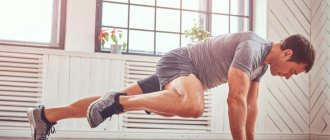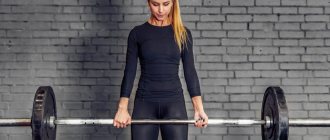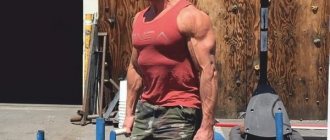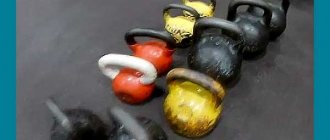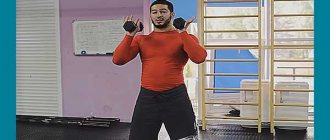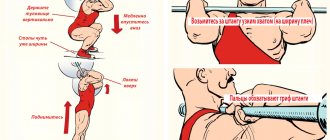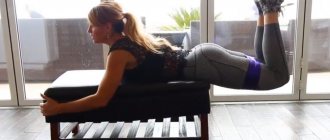The powerlifting squat is the exercise that sets the tone for the entire performance in a powerlifting competition. If you squat down (and, importantly, stand up) with a lot of weight, your opponents start to get nervous and order weights that they are not capable of in an attempt to catch up with you. So a good result in squatting means not only a purely physical advantage, but also an advantage in tactical combat with opponents. How to increase your results in squats will be discussed in this article.
The powerlifting squat is an exercise that can only progress if the lifter pays close attention to technique and avoids overtraining.
The main reason why new powerlifters and even experienced athletes do not make progress in the squat is either a fear of heavy weights or overtraining.
What muscles work during barbell squats?
One of the main exercises for working the muscles of the legs and back is the squat with a barbell. How to increase weight? First, let's explain which muscles are involved when performing the exercise.
Although many people believe that squats are purely leg exercises, they are wrong. In addition to the load on the muscle groups of the legs (buttocks, quadriceps, hamstrings), the entire lower part of the body is involved in the work, including the lumbar and abdominal areas. It is also known that the limiting factor in performing squats with a barbell is the erector muscles of the back, and not the muscles of the legs. That is why this exercise must be performed carefully, under the supervision of an instructor.
The back gets really seriously involved when an athlete performs this type of squat. In this regard, before you begin to perform this exercise, even with a small additional weight, it is necessary to master the technique of squats with a barbell in a perfect manner. If an athlete has certain back problems, it is recommended to consult with a coach or other specialist who will help decide whether it is worth doing barbell squats at all or whether it is better to replace them with alternative training.
PLANNING YOUR SQUATS
| Monday | Wednesday | Friday |
| WEEK 1 | ||
| Squats - 60%, 10x5, rest 45-60 sec | Front squats – 55/60/65/70/75%x5 | Squats – work up to 10RM |
| WEEK 2 | ||
| Squats – 67.5%, 10x4, rest 75-90 sec | Front squats – 60/65/70/75/80%x3 | Squats – work up to 8RM |
| WEEK 3 | ||
| Squats – 75%, 10x3, rest 105-120 sec | Front squats–65x5, 70x4 75x3, 80x2, 85%x1+ | Squats – work up to 5RM |
| WEEK 4 (UNLOADING) | ||
| Squats – 60%, 5x3 | Front squats–60% 3x3 | Squats – release and hold 95% of target max for 10 seconds |
| WEEK 5 | ||
| Squats – 65%, 8x5, rest 60-75 sec | Front squats – 60/67.5/75/82.5%x4 | Squats – work up to 8RM |
| WEEK 6 | ||
| Squats – 72.5%, 8x4, rest 90-105 sec | Front squats – 65/72.5%x3, 80/87.5%x2 | Squats – work up to 5RM |
| WEEK 7 | ||
| Squats – 80%, 8x3, rest 120-135 sec | Front squats–70x4, 77.5x3, 85x2, 92.5%x1+ | Squats – work up to 3RM |
| WEEK 8 (UNLOADING) | ||
| Squats – 65%, 5x3 | Front squats–65% 3x3 | Squats – release and hold 100% of target max for 10 seconds |
| WEEK 9 | ||
| Squats – 70%, 5x5, rest 75-90 sec | Front squats – 65/75/85%x3 | Squats – work up to 5RM |
| WEEK 10 | ||
| Squats – 77.5%, 5x4, rest 105-120 sec | Front squats – 70/80/90%x2 | Squats – work up to 3RM |
| WEEK 11 | ||
| Squats – 85%, 5x3, rest 135-150 sec | Front squats–75x3, 85x2, 95%x1+ | Squats – work up to 2RM |
| WEEK 12 (UNLOADING) | ||
| Squats – 70%, 5x3 | Front squats–70%, 3x3 | Squats – release and hold 105% of target max for 10 seconds |
| WEEK 13 (PASSING) | ||
| Front squats – up to 1RM | Rest | Squats – up to 1RM |
Sometimes the weights feel light, sometimes heavy, create your plan and work. Since rep maxes are repeated (8RM, 5RM, 3RM), adding even 5 pounds is progress and can be described as “it’s a marathon, not a sprint.” I would recommend not using the belt unless necessary, try not to wear the belt on Mondays and all but the main sets on Wednesdays, and in the first weeks on Fridays/Saturdays for rep maxes.
As for the accessory, if you are using this program for powerlifting, 2-5 sets of exercises for quads with an emphasis on single leg exercises (step-ups, lunges, split squats), hamstrings/lumbar exercises (GHR, reverse hyperextensions, good mornings) , bending) and the press will be enough. If you want to use this program for CrossFit, keep reading.
If you squat, will your butt muscles get bigger?
The Internet and social networks are full of information that squats are the best exercise for increasing the size of the buttocks, but this is not true. Even if an athlete knows how to increase the weight of a barbell squat and believes that this way he will be able to increase his buttocks, the results from such training will be somewhat different than he expects. Squats, and even more so squats with a barbell, really increase strength and muscle volume, but this mainly concerns the quadriceps and lumbar region. The buttocks also get a load, but it is much less than many people think.
To pump up beautiful buttocks, in addition to squats with a barbell, you should include in your program exercises that involve more horizontal movements and less movement in the knee joints, for example, raising and lowering the entire body to a certain height, leg lunges, and others.
OTHER LIFTS
Now that we've talked about squats, what about other lifts? Before we start talking about the bench press and deadlift, let me discuss one issue.
Can the cowboy method be applied to the bench press? Certainly! Don't press and squat at the same time, although if the squat is strong and the press is lagging, then give it a chance. Use the same percentages, but do bench presses instead of squats and overhead presses instead of front squats.
Can you apply the cowboy method to deadlifts? Maybe. Personally I wouldn't, 3 deadlifts a week can be fatal, but if you manage it you can get good at it. I would do high volume work (Monday) from low stands in the competition position, medium volume work (Wednesday) from medium stands in the opposite position to the competition position, and heavy work in the competition position from the floor.
Considering that we're doing the bench press in conjunction with the squat as our primary lift, there are 2 different ways to incorporate the bench press into the plan. These will depend on your schedule and your bench press ability.
The first route is for a weaker bencher who needs higher volume. In general, this mirrors the reverse volume squat program. So we do a heavy bench press on Monday, a medium volume overhead press on Wednesday, and a high volume bench press on Friday.
A complete training cycle for the bench press would look like this...
Technique for performing squats without load
To avoid injury and to train your legs and glutes properly, you should first practice unloaded squats, since this way you can quickly master the necessary technique. The following steps will help you do this:
- The athlete stands on his feet, the width of which should be equal to the width of his shoulders.
- The feet should be turned outward approximately 30 degrees.
- In this position, you need to lower your body, bending your knees and imitating sitting on a chair.
- It is important to ensure that your bent knees do not protrude beyond your toes, otherwise you can damage the knee joint.
Heavy squats at 2/3
Once you've gotten used to having a heavy weight on your back, the next step is to start performing a full squat, and a partial squat at the top of the movement is a great way to boost your confidence and gain muscle.
Working through only one part of the range of motion allows you to lift more weight than with full, high-repetition squats. This way you can train your muscles to a much greater limit.
Set the safety bars to 1/3 of the entire length of the squat. But they should be set low enough that you don't just bend your knees.
In addition to gaining confidence and mass, you'll also improve your connective tissue and be ready for hard work.
Barbell squat technique
The athlete must master the technique of performing a squat with a barbell. How to increase weight should be considered only after this. You need to pay attention to the position of the bar itself. This sports equipment should be placed on the back of the head, taking it with a wide grip. The elbows should be in line with the knees, and the hands should be holding the bar.
The correct technique for squatting with a barbell involves paying the athlete’s attention not only to the starting position, but also to the movements themselves, namely, during squats, the bar should not move vertically, but at a certain angle to the floor surface. The starting position for barbell squats is the athlete's position at the bottom. You need to start the exercise by lifting your pelvis, then gradually straighten your legs at the knees and lift your whole body.
It is incorrect to begin lifting the body with movement in the knee joints; this leads to a significant increase in the load on them, and therefore to the risk of serious injury.
Finally, you need to pay attention to proper breathing techniques. If there is air in the athlete’s lungs, then by exhaling it, he will help himself to lift from the lower position, that is, it is recommended to inhale when the athlete is lowering.
Heavy Barbell Steps
Barbell steps work well with the heavy back hold described above. But don’t get too carried away, as you did with the hold - somewhere around 10-15% of the one-rep maximum will do the trick.
Obviously, there will be movement of the legs and knees, which means the risk that something could go wrong is an order of magnitude higher. Leave your ego at home and train smart. Set the belay bars as high as possible and, if possible, have someone belay you.
Remove the weight, tense your muscles, then take a few steps back and stand as if you were about to squat. But don't sit down. Just stand there for 8-10 seconds, contracting your core and upper back.
After you have stood for 8-10 seconds, walk back to the racks and set the bar down.
Again, once you get used to walking with a heavy weight on your back, your working weight will no longer feel at all heavy.
You'll also need a lot more confidence to tackle something really tough. When I was training to break the Canadian squat record (210.5 kg, 463 lbs) with 83 kg bodyweight, I loaded the barbell to 465 lbs every workout.
The first time I tried this weight, I felt like my spine was going to explode. The second time I tried it, I took a few steps with this weight. After that, I did the exercise a couple more times, and by the fourth time I thought, “This isn’t so bad.”
After 2 weeks I did a full squat with this weight. This gave me great confidence going into the competition where I broke the record on my second attempt.
Types of squats with a barbell
Classic squats with a barbell have recently been heavily criticized by many experts, since this exercise negatively affects the health of the back. Therefore, other types of squats with weights were introduced into the practice of training athletes:
- with front position of the rod;
- with a hexagonal rod;
- Bulgarian squat.
How much weight should you use for a barbell squat?
This question is quite complex, and at present experts cannot come to a definite answer to it. The fact is that recent research on a group of athletes demonstrated that those athletes who lifted heavier weights, performing fewer repetitions of the exercise, grew muscle mass and developed physical strength in exactly the same way as the group of athletes who worked with lighter weights , but with a large number of repetitions of the exercise.
What weight should I start with in a barbell squat? Of course, from a small point. For example, you can start with 10 kg. As soon as the athlete begins to squat with such a weight, doing a set of 3 series of 10-12 repetitions 2 times a week and at the same time applying 60-70% of his efforts, then it is recommended to increase the weight of the bar by 5 kg. Based on the figures given, you can increase your weight constantly.
How to increase the weight in the barbell squat if an athlete wants to build more muscle mass in the legs? In this case, he must select the weight of the projectile so that during the squats he gives 90-95% of his effort, performing only 3-5 repetitions. It is recommended to perform squats with heavy weights once a week to give the muscles enough time to recover. With this training plan, the athlete will be able to quickly progress in the matter of working with heavy weights.
It should be warned in advance that heavy weights increase the risk of injury to the knee joint and back, so the athlete must concentrate every second on the correct technique of performing squats.
Foot width
It needs to be varied until the athlete finds a comfortable position. In it, the pelvis at the lowest point of the sit should not twist, the knees should calmly spread in the direction of the toes, and the heel should not come off the platform. All other stances that are strongly advised to “use too” can be auxiliary - to shift the load vector and additional muscle development. They have no other purpose.
General rules - the longer the legs and the taller the height, the wider the stance is optimal for lifting more weight. The limiting factor is the structure of the athlete’s pelvis. Sometimes “opening” the pelvic bones to the optimal width is not anatomically possible, so medium or narrow foot placement is used. Normally, the heels should be approximately under the shoulder joints or a few centimeters wider.
There may be several options:
- Raising the barbell from the point where the weight stops. The higher the dead center is from the floor, the more weight you should use on the bar, up to well above the maximum limit, the bar is installed on the safety stop of the power frame, and the lift is made from this point;
- Pause on lowering and rising at this point of amplitude;
- Bench squats;
- Working with spacers - chains, rubber, safety bar.
Working with pauses and separators is optimal in relation to partial lifting. It is difficult to take the starting position correctly, which leads to injuries.
Anyone can learn to squat. Of course, everyone has their own strengths and weaknesses, but you shouldn’t refuse to move if there are no contraindications. It is better to entrust the analysis of errors, techniques and weaknesses to a person who understands this. Ideally, a powerlifting or weightlifting coach. This will significantly speed up the path to progress in strength indicators. When working independently, it is better to shoot a video and try to look at the work from the outside. It is worth remembering that the lack of progress in strength may be due to a calorie deficit, the general focus of the training plan on burning fat. And progress does not come to those who train chaotically and do exercises according to the principle “I saw a fitness model on Instagram.” Work with specialists, study the technique, and the working weights will begin to increase.
Common Mistakes
We cannot remain silent about the mistakes that athletes often make when performing squats with a barbell. How to increase weight can only be considered after proper mastery of the technique. The main mistake is to lean your back forward before bending your knees and lowering your body. Your back should be straight while performing squats.
Another mistake is incorrect position of the barbell. Many novice athletes make efforts with their hands to hold the barbell, which is correct when the apparatus rests completely on the bones of the shoulders. In this case, the hands only stabilize his position.
Impact on the lower back and knees
Injured athletes and people with hyperlordosis should be conscious about squat training. Many people should not perform squats, at least until full recovery has been achieved.
The movement itself is not dangerous to the lower back and knees, and with weights no greater than your own can be performed without benders, bandages, or a belt.
To prevent injury, you need to pay attention to:
- Press work . The stomach should not fall forward and be relaxed. The belt push is performed only if the athlete does power squats; it should be avoided in fitness;
- Initial position of the pelvis . There is no need to stretch your buttocks upward, as we often see in photos from fitness magazines. It looks beautiful, but is very traumatic for the lower back;
- The position of the knees . They move in the plane of the foot, towards the toes, rather than inward;
- Ankle mobility . If your shin is “clogged” from walking in heels or trying to pump up your calves, you should roll it with a roller and stretch it a little before you start squatting.
Reviews from athletes about barbell squats
According to numerous experts, barbell squats are an effective exercise for increasing leg muscle mass, which is why they are part of most weightlifting training programs. Moreover, they recommend starting with light weights and a large number of repetitions of the exercise, training 2-3 times a week, and then gradually moving to heavy weights, a small number of repetitions and training 1-2 times a week.
There are also reviews according to which athletes often injure their backs due to the fact that they perform squats to the wrong depth.
WANT TO SQUAT MORE? SQUAT MORE!
The Cowboy Method grew out of the Texas Method. I originally called it the Big Texas Method, but the Cowboy Method sounds better and the Big Texas Method makes me think of the cinnamon rolls you buy in the vending machine.
The origins of the Cowboy Method were found in Glenn Pendlay's Texas Method squat program. The Texas Pendley Method involves 3 workouts per week with high volume on Mondays, low volume on Wednesdays and high reps on Fridays or Saturdays; Overall, this is a great program that will lead you to excellent results.
Like most people reading this, you need more, you need more size, more muscle, more practice with the exercises, and the cowboy method will provide it all. If you are a beginner or intermediate lifter, you need more VOLUME, if you are an advanced lifter, a high volume phase can help you build muscle, give you a break from heavy weights and the opportunity to train in a new way.
Let's digress for one minute on a very important point. YOU MUST BE HONEST WITH YOURSELF ABOUT YOUR LEVEL. I squatted 800 pounds at my first powerlifting meet and considered my performance to be average. The lifter is an average person with advanced talent. Before that, I trained for 12 years and only felt perspective at that moment.
Most beginner and intermediate lifters need more volume for two main reasons:
- they are ineffective and under stimulated by low volume/high intensity compared to advanced lifters;
- they need to practice more to become more effective. If your sport is powerlifting, then the squat performed in competition is sports practice - don't lose sight of this fact.
The increased workload of the cowboy method will give you the opportunity to build muscle in your body, improving your squat technique and movement efficiency. And what is important for this, or any program, is that you become more confident by successfully lifting all the weights planned. The weights you don't lift don't make you stronger; the weights you lift make you stronger.
Set your weekly rep max and try to make small increases from week to week. This small amount of progress will lead to continued gains over time. Once you have established your target rep max, use the last week's results as a guide and make small increases to your target rep max (3-5 pounds) each week using the following equation:
(WEIGHT X REPS X 0.033) + WEIGHT = ESTIMATED MAXIMUM
Remember that an estimated max based on a higher rep range (6-10 reps) is less accurate than an estimated max based on a lower rep range. Rep max tends to be higher for women or lighter lifters.

